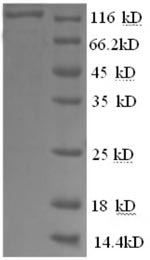Recombinant Human Glycogen Phosphorylase, brain form (PYGB), is produced in E. coli and includes the 6-843 amino acid region. This partial protein carries an N-terminal GST tag and shows purity exceeding 90% when measured by SDS-PAGE. The product is intended for research use only, offering what appears to be a dependable tool for studies that require high-purity recombinant proteins.
Glycogen phosphorylase, brain form (PYGB), plays a crucial role in glycogen metabolism by catalyzing the breakdown of glycogen to glucose-1-phosphate. This process seems essential for maintaining energy homeostasis in brain tissue, particularly under conditions of high energy demand. PYGB's involvement in energy metabolism makes it an important focus of research in neurobiology and related metabolic studies.
Potential Applications
Note: The applications listed below are based on what we know about this protein's biological functions, published research, and experience from experts in the field. However, we haven't fully tested all of these applications ourselves yet. We'd recommend running some preliminary tests first to make sure they work for your specific research goals.
Based on the provided information, recombinant human PYGB is produced in an E. coli expression system as a partial fragment (6-843aa) with an N-terminal GST tag. PYGB is a complex eukaryotic enzyme that requires precise folding, dimerization, and cofactor binding (PLP) for its catalytic activity in glycogen metabolism. E. coli expression systems cannot provide the necessary eukaryotic folding environment and may lack proper cofactor incorporation. The large GST tag (≈26 kDa) may cause significant steric interference with the protein's functional domains. The partial nature of the construct (missing first 5 amino acids) may also affect proper folding. Purity >90% by SDS-PAGE under denaturing conditions does not confirm native folding or bioactivity. No validation data (e.g., enzymatic activity assays, cofactor binding tests) are provided. Therefore, the protein is highly likely to be misfolded and inactive for enzymatic functions.
1. Antibody Development and Validation
This application is suitable as antibody generation primarily relies on linear epitope recognition. The GST tag facilitates purification and immobilization for antibody screening. However, antibodies generated against potentially misfolded proteins may not optimally recognize conformation-dependent epitopes of native PYGB in biological contexts.
2. Biophysical Characterization
These studies are essential for determining folding status. Techniques should include circular dichroism spectroscopy to assess secondary structure, size-exclusion chromatography to evaluate oligomeric state, and thermal stability assays. However, results will describe this specific fragment rather than the native PYGB protein.
Final Recommendation & Action Plan
This E. coli-expressed GST-tagged partial PYGB is unsuitable for functional studies without rigorous validation due to the high probability of misfolding and lack of essential cofactors. Recommended actions: (1) Validate folding through biophysical methods (circular dichroism, size-exclusion chromatography) and functional activity with glycogen phosphorylase assays; (2) For reliable results, consider eukaryotic expression systems (mammalian or insect cells) that support proper folding and cofactor incorporation; (3) Remove GST tag if used for structural or functional studies; (4) Antibody development can proceed but requires validation against native protein; (5) Avoid activity assays and drug screening unless proper folding and bioactivity are conclusively demonstrated. Always include positive controls and consider using commercially available active PYGB as a benchmark.






